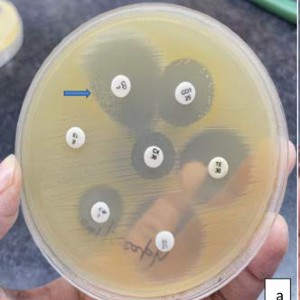Prevalence of MLSB Phenotypes of Staphylococcus aureus isolates in a tertiary care hospital of Delhi

Accepted: 7 June 2023
HTML: 9
All claims expressed in this article are solely those of the authors and do not necessarily represent those of their affiliated organizations, or those of the publisher, the editors and the reviewers. Any product that may be evaluated in this article or claim that may be made by its manufacturer is not guaranteed or endorsed by the publisher.
Against the backdrop of the ever-changing Staphylococcal resistance pattern, clindamycin remains a viable therapeutic alternative Variation of Clindamycin drug resistance patterns with geographic area make inducible clindamycin resistance testing imperative for all staphylococcal isolates to avoid therapeutic failure. This was a prospective study conducted over a period of 1.5 years from January 2021 until June 2022. Prevalence of different MLSB Phenotypes of Staphylococcus aureus isolates was determined by standard disc diffusion method as per CLSI guidelines. Pyogenic samples received in the Microbiology lab that yielded Staphylococcus aureus were further tested for the presence of clindamycin resistance by disc diffusion method. Out of 6586 total pyogenic and respiratory specimens received in the lab, Staphylococcus aureus was yielded in 752 samples. On further testing for the MLSB phenotypes, 16.3% isolates were found to be iMLSB, 19.28% were cMLSB, 43.1% were of MSB type. ICR screening will reduce the unessential subjection of the patient to the antibiotic, and would prevent unnecessary adverse effects in the patients.
Clindamycin: An overview - UpToDate. Accessed 2023 May 11. Available from: https://www.uptodate.com/contents/clindamycin-an-overview?search=clindamycin%20in%20staphylococcal%20infections&source=search_result&selectedTitle=3~150&usage_type=default&display_rank=3#H12
Alpha Toxin - an overview | ScienceDirect Topics. Accessed 2023 May 11. Available from: https://www.sciencedirect.com/topics/medicine-and-dentistry/alpha-toxin
Morgan M. Staphylococcus aureus, Panton-Valentine leukocidin, and necrotising pneumonia. BMJ 2005;331:793–4. DOI: https://doi.org/10.1136/bmj.331.7520.793
Saribas Z, Tunckanat F, Pinar A. Prevalence of erm genes encoding macrolide-lincosamide-streptogramin (MLS) resistance among clinical isolates of Staphylococcus aureus in a Turkish university hospital. Clin Microbiol Infect 2006;12:797–9. DOI: https://doi.org/10.1111/j.1469-0691.2006.01486.x
Ghanbari F, Ghajavand H, Havaei R, et al. Distribution of erm genes among Staphylococcus aureus isolates with inducible resistance to clindamycin in Isfahan, Iran. Adv Biomed Res 2016;5:62. DOI: https://doi.org/10.4103/2277-9175.179184
CLSI-31-2021.pdf. Accessed 2022 Oct 9. Available from: https://www.treata.academy/wp-content/uploads/2021/03/CLSI-31-2021.pdf
Moellering, Jr. RC. Current treatment options for community‐acquired methicillin‐resistant Staphylococcus aureus infection. Clin Infect Dis 2008;46:1032–7. DOI: https://doi.org/10.1086/529445
Nahar L, Hagiya H, Nada T, et al. Prevalence of Inducible Macrolide, Lincosamide, and Streptogramin B (inducible MLSB) Resistance in Clindamycin-Susceptible Staphylococcus aureus at Okayama University Hospital. Acta Med Okayama 2023;77.
Kumar S, Bandyopadhyay M, Bhattacharya K, et al. Inducible clindamycin resistance in staphylococcus isolates from a tertiary care hospital in Eastern India. Ann Trop Med Public Health 2012;5:468. DOI: https://doi.org/10.4103/1755-6783.105134
Lall M, Sahni AK. Prevalence of inducible clindamycin resistance in Staphylococcus aureus isolated from clinical samples. Med J Armed Forces India 2014;70:43–7. DOI: https://doi.org/10.1016/j.mjafi.2013.01.004
Mokta KK, Verma S, Chauhan D, et al. Inducible clindamycin resistance among clinical isolates of Staphylococcus aureus from sub himalayan region of India. J Clin Diagn Res JCDR 2015;9:DC20–3. DOI: https://doi.org/10.7860/JCDR/2015/13846.6382
Deotale V, Mendiratta D, Raut U, Narang P. Inducible clindamycin resistance in Staphylococcus aureus isolated from clinical samples. Indian J Med Microbiol 2010;28:124–6. DOI: https://doi.org/10.4103/0255-0857.62488
Adhikari RP, Shrestha S, Barakoti A, Amatya R. Inducible clindamycin and methicillin resistant Staphylococcus aureus in a tertiary care hospital, Kathmandu, Nepal. BMC Infect Dis 2017;17:483. DOI: https://doi.org/10.1186/s12879-017-2584-5
Supriyarajvi, Gupta A, Tina G, Sharma BP. Detection of inducible clindamycin resistance among Staphylococcal isolates from various clinical specimens in a tertiary care institute in north west region of Rajasthan, India. Int J Curr Microbiol Appl Sci 2015;4:741–9.
Molecular Characterisation of Methicillin-Resistant Staphylococcus aureus Isolated from Patients at a Tertiary Care Hospital in Hyderabad, South India. Indian J Med Microbiol 2020;38:183–92. DOI: https://doi.org/10.4103/ijmm.IJMM_20_151
Schreckenberger PC, Ilendo E, Ristow KL. Incidence of constitutive and inducible clindamycin resistance in Staphylococcus aureus and coagulase-negative staphylococci in a community and a tertiary care hospital. J Clin Microbiol 2004;42:2777–9. DOI: https://doi.org/10.1128/JCM.42.6.2777-2779.2004
Copyright (c) 2023 the Author(s)

This work is licensed under a Creative Commons Attribution-NonCommercial 4.0 International License.


 https://doi.org/10.4081/hls.2023.11229
https://doi.org/10.4081/hls.2023.11229



